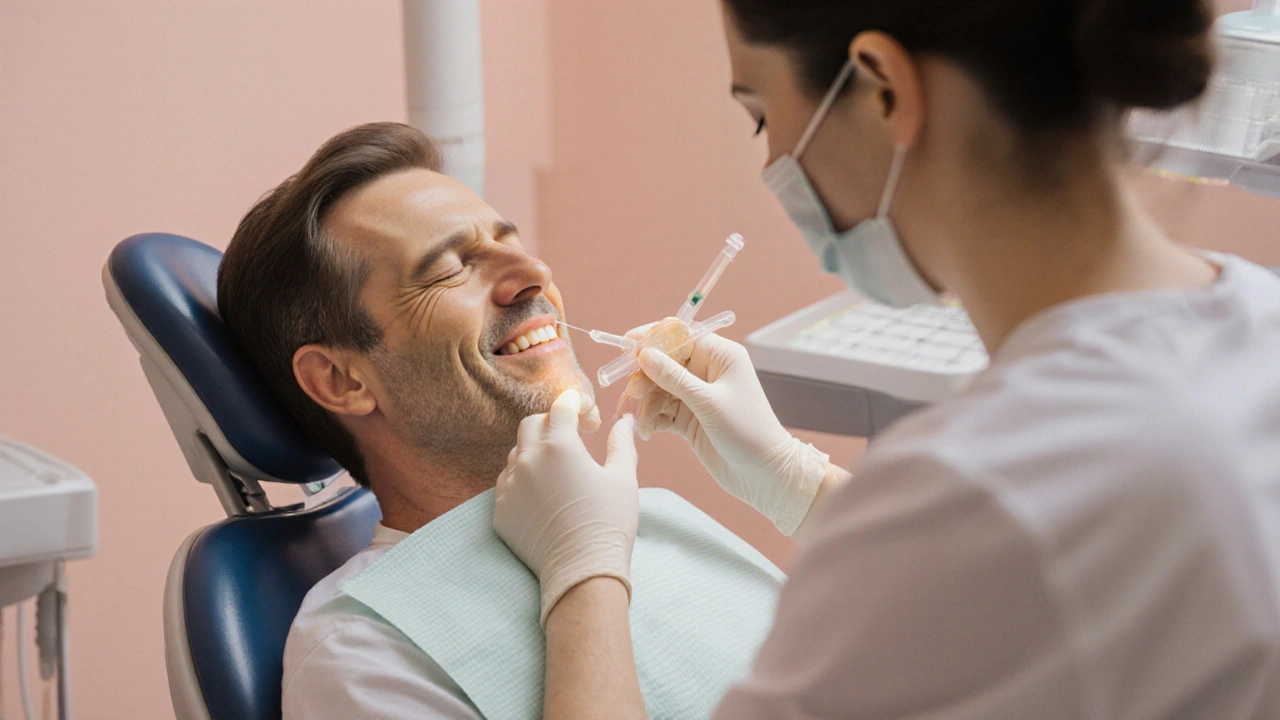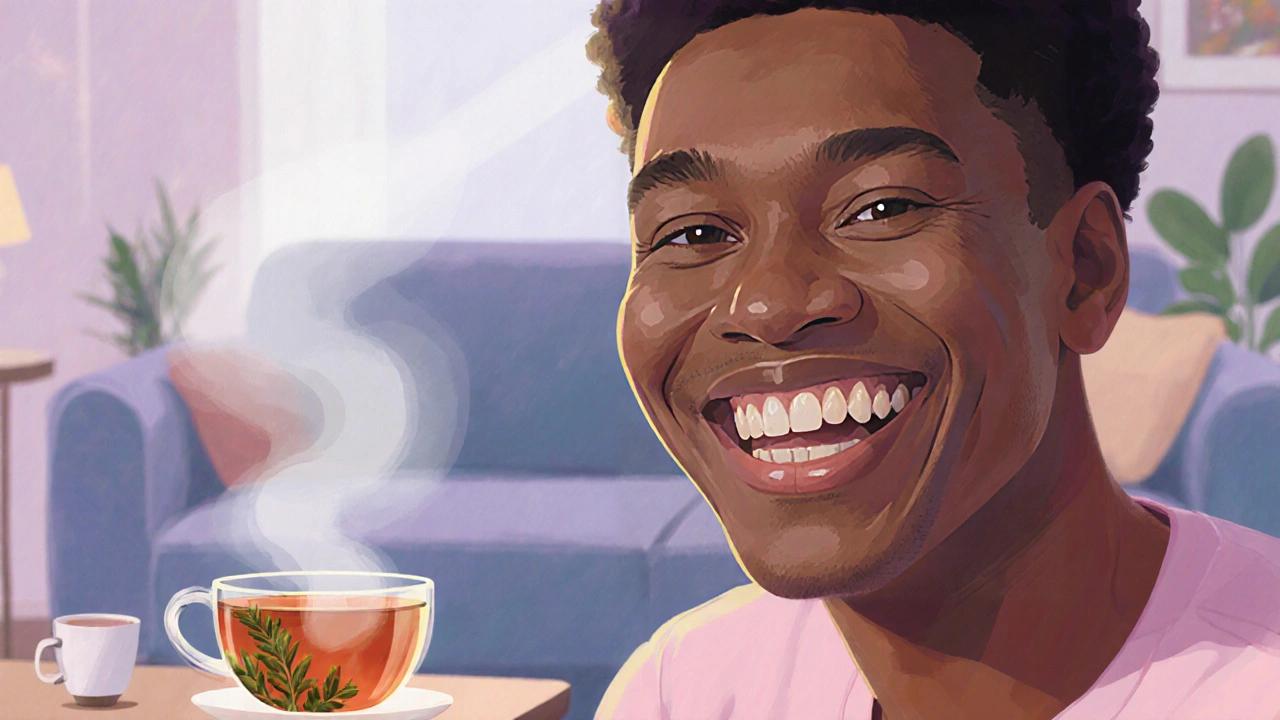How Local Anesthesia Affects Dental Patients' Quality of Life
 Sep, 26 2025
Sep, 26 2025
Local anesthesia is a reversible drug‑induced loss of sensation applied directly to oral tissues that enables dentists to perform procedures without causing pain. By blocking nerve signals, it directly influences how a patient feels during and after treatment, which in turn shapes their everyday wellbeing.
Why Local Anesthesia Matters in Dentistry
When a dentist says, “You’ll feel a pinch, then nothing,” the promise hinges on a reliable anesthetic effect. Without it, even routine clean‑ups become a source of dread, pushing patients to avoid care altogether. This avoidance can lead to cavities, gum disease, and ultimately a lower quality of life a multidimensional measure of physical, emotional, and social wellbeing that goes far beyond the dental chair.
How Local Anesthesia Works: The Science of Nerve Block
At the core of the process is the dental pulp the soft tissue inside each tooth containing nerves and blood vessels. When an anesthetic is injected near the pulp, it diffuses across the surrounding nerve block a technique that surrounds a nerve with medication to halt signal transmission. The drug binds to sodium channels on nerve membranes, preventing the rapid influx of ions that would otherwise spark pain signals to the brain.
Common Anesthetic Agents: Lidocaine vs. Articaine
Dentists usually choose between a few well‑studied drugs. The two most popular are Lidocaine an amide anesthetic with a typical concentration of 2% and a duration of 60-120minutes and Articaine a newer amide anesthetic (4% concentration) that penetrates bone more efficiently and lasts 75-180minutes. Both are safe when used correctly, but they differ in onset speed, potency, and risk profile.
| Attribute | Lidocaine | Articaine |
|---|---|---|
| Typical concentration | 2% | 4% |
| Onset time | 2-4minutes | 1-3minutes |
| Duration of soft‑tissue anesthesia | 60-120minutes | 75-180minutes |
| Bone penetration | Moderate | High (due to thiophene ring) |
| Incidence of paresthesia | ~0.05% | ~0.2% |
Choosing the right agent can reduce the number of injections, shorten chair time, and therefore lessen the stress that patients associate with dental visits.
Managing Post‑Operative Pain
Effective local anesthesia not only numbs the patient while the drill runs; it also sets the stage for smoother recovery. When the anesthetic wears off gradually, the body experiences a slower return of sensation, which translates into lower peaks of post‑operative pain pain that follows a dental procedure, typically within the first 24hours. Studies from the American Dental Association show that patients who receive a proper nerve block report a 30% reduction in pain medication consumption compared with those who rely only on topical gels.
Reducing Dental Anxiety
Fear of pain is the leading cause of dental anxiety a heightened emotional response that can range from mild unease to full‑blown phobia. When patients know they will be numb, the brain’s threat circuitry stays calmer, which lowers cortisol spikes and prevents the fight‑or‑flight response. A 2023 survey of 1,200 adult dental patients found that 68% cited “confidence in the anesthetic” as the primary reason they finally booked an appointment after years of avoidance.

Impact on Daily Activities and Overall Quality of Life
After the procedure, the lingering numbing effect can affect speech, eating, and even facial expressions. However, when the anesthetic is calibrated correctly-enough to block pain but not so much that it hampers normal function-patients often resume regular meals within two hours. This swift return to normalcy preserves the Oral Health‑Related Quality of Life (OHQoL) a validated metric that captures how oral health influences daily activities, self‑esteem, and social interactions. In longitudinal studies, patients who consistently received appropriate local anesthesia reported higher OHQoL scores at 6‑month follow‑ups compared with those who experienced inadequate numbness.
Measuring Success: Patient‑Reported Outcomes
Most dental practices now collect feedback using standardized questionnaires such as the Dental Pain and Anxiety Scale (DPAS) a 10‑item survey rating pain intensity and anxiety on a 0-10 scale. When clinicians cross‑reference DPAS scores with the type and dosage of local anesthetic used, clear patterns emerge: higher doses of Articaine correlate with lower pain scores, while excessive lidocaine can sometimes prolong numbness and delay eating, marginally decreasing satisfaction.
Practical Tips for Patients
- Discuss any previous reactions to anesthetics; this helps the dentist choose the safest option.
- Ask about the expected duration of numbness so you can plan meals and avoid chewing on the numb side.
- Use a cold compress after surgery to further reduce swelling; it works synergistically with the anesthetic’s anti‑inflammatory effect.
- If you experience lingering tingling after 24hours, contact your dentist-rare paresthesia can be addressed early.
Guidance for Dental Professionals
- Perform a thorough medical history review; systemic conditions like liver disease can alter anesthetic metabolism.
- Consider using buffered anesthetic solutions to reduce injection pain and speed onset.
- Document the exact volume and concentration administered; this data supports later outcome analysis.
- Combine local anesthesia with gentle communication techniques-explaining each step lowers patient anxiety and improves perceived comfort.
Related Concepts and Next Steps
Local anesthesia sits at the intersection of several broader topics. sedation dentistry the use of oral, inhalation, or IV agents to induce a deeper state of relaxation than topical or local anesthetics alone is an option for highly anxious patients who still need reliable pain control. Meanwhile, advances in computer‑guided injection systems devices that use 3‑D imaging to place anesthetic precisely at the nerve entry point promise even faster onset and fewer needle sticks.
Future reads that naturally follow this article include:
- "Sedation vs. Local Anesthesia: When to Choose Each"
- "Understanding Oral Health‑Related Quality of Life Metrics"
- "New Formulations of Articaine and Their Clinical Benefits"

Frequently Asked Questions
How long does the numbness from local anesthesia usually last?
Typical soft‑tissue numbness lasts between 1 and 3hours, depending on the drug used, the concentration, and the injection site. Bone‑related procedures may extend the sensation slightly longer.
Is it safe to eat while my mouth is still numb?
It’s best to avoid chewing on the numbed side until feeling returns. Accidentally biting the tongue or cheek can cause injury because the tissue can’t signal pain.
Can I be allergic to lidocaine or articaine?
True allergies are rare (<0.1%). Most reactions are mild, such as temporary tingling. If you’ve experienced an allergic reaction to one amide anesthetic, your dentist will likely switch to a different class, such as a ester anesthetic.
Why do some patients feel pressure instead of pain during injection?
The pressure comes from the fluid entering the tissue. Using a slow injection technique or a buffered solution reduces that sensation, making the experience more comfortable.
Does local anesthesia affect my ability to speak after the procedure?
Mild slurring can occur while the tongue or lips are numb, but most patients regain clear speech within 30‑60minutes as the anesthetic wears off.
henry leathem
September 26, 2025 AT 21:42Your overreliance on jargon shows you’re more interested in sounding smart than helping patients.
jeff lamore
October 3, 2025 AT 20:22I appreciate the thorough overview; the distinctions between lidocaine and articaine are clearly laid out.
Kris cree9
October 10, 2025 AT 19:02Honestly this article is a travesty lol u guys forgot to mention the nightmare of numbing the tongue and just made it sound like a spa day!
Paula Hines
October 17, 2025 AT 17:42Local anesthesia is the unsung hero of modern dentistry. It allows the practitioner to perform delicate work without provoking the primal fear of pain. When the anesthetic binds to sodium channels the neuronal fire is halted and the patient experiences relief. This biochemical blockade translates into a psychological calm that extends beyond the chair. In the United States we have pioneered the development of articaine formulations that penetrate bone more efficiently. Such advancements have reduced the number of needle sticks and therefore the trauma associated with dental visits. The reduced trauma supports a higher quality of life for citizens who can maintain oral health without dread. Studies show a direct correlation between effective numbing and lower cortisol levels. Lower cortisol improves immune function and promotes overall wellbeing. Patients who recover quickly can return to work and family duties without interruption. The economic benefits of a healthy population reverberate through our communities. Moreover the ethical duty of the dentist aligns with the national interest in preserving public health. By documenting dosage and outcomes we create data that fuels further innovation. Future researchers will build upon this foundation to create even faster onset agents. The ultimate goal remains a painless smile for every American. In this pursuit the collaboration between clinicians and scientists becomes a patriotic endeavor.
John Babko
October 24, 2025 AT 16:22Wow!!! This breakdown of lidocaine vs. articaine is spot‑on, and the data table is crystal‑clear, making it so easy to pick the right drug!!!
Stacy McAlpine
October 31, 2025 AT 14:02One practical tip is to ask your dentist about buffering the anesthetic; it can cut the sting of the injection and speed onset.
Roger Perez
November 7, 2025 AT 12:42Great tip! 😊 Also, keep a soft food stash handy so you don’t accidently bite your cheek when the numbness fades. 🍦
michael santoso
November 14, 2025 AT 11:22While the emotive language captures patient frustration, the evidence indicates that adverse events are statistically rare; a balanced risk‑benefit analysis should guide drug selection.
M2lifestyle Prem nagar
November 21, 2025 AT 10:02Stay positive-effective anesthesia is your passport to a pain‑free smile!
Karen Ballard
November 28, 2025 AT 08:42Absolutely! 👍 Proper numbing empowers patients to maintain oral hygiene without fear. 😊
Gina Lola
December 5, 2025 AT 07:22The DPAS scores really reflect the subjective pain axis and make for solid patient‑reported outcomes.
Leah Hawthorne
December 12, 2025 AT 06:02True, those metrics give us a window into how anesthetic duration influences daily activities like eating and speaking.
Brian Mavigliano
December 19, 2025 AT 04:42But what if the focus on numbers masks the artistry of patient care; perhaps we should trust clinical intuition over every questionnaire.